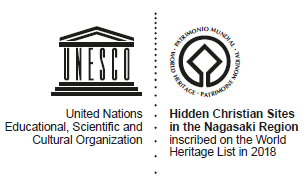 |
In order for a property to be inscribed on the UNESCO World Heritage List, it is necessary to demonstrate the property’s exceptional significance (“Outstanding Universal Value”) from an international viewpoint and the implementation of effective preservation and management. |
Outstanding Universal Value
The nominated property, ‘Hidden Christian Sites in the Nagasaki Region’, bears unique testimony to the history of people and their communities who secretly transmitted their faith in Christianity during the time of prohibition spanning more than two centuries in Japan, from the 17th to the 19th century. Located in very remote areas including small islands at the westernmost edge of Japan, the property represents how the Christian communities survived in the midst of the conventional society and its religions, gradually transforming and ultimately ending their religious traditions and being assimilated into modern society after the prohibition was lifted.
The nominated property is comprised of 12 components located in the Nagasaki region of Japan, which lies at the far eastern edge of the area within Asia in which Christianity was introduced during the Age of Exploration. Since the Nagasaki region served as Japan’s gateway for exchange with foreign countries and as a place where missionaries settled from the latter half of the 16th century, people in the region could receive missionaries’ guidance extensively over a long period of time, and as a result, Catholic communities took root more firmly there than anywhere else in Japan. In this context, even after Japan banned Christianity in the 17th century and not a single missionary was allowed to remain in Japan, some Catholics in the Nagasaki region were left to maintain their faith and small religious communities by themselves, becoming Hidden Christians.
Hidden Christians survived as communities that formed small villages sited along the seacoast or on remote islands to which the Hidden Christians migrated during the ban on Christianity. Hidden Christians gave rise to a distinctive religious tradition that was seemingly vernacular yet which maintained the essence of Christianity, and they survived continuing their faith over the ensuing two centuries.
The nominated property as a set of the 12 different components provides a clear understanding of the tradition of Hidden Christians. The nominated property thus bears testimony to the distinctive way in which the Hidden Christians continued their faith during the ban on Christianity. As witness to this unique cultural tradition nurtured during the long ban on Christianity, the nominated property has Outstanding Universal Value.
Justification for Criteria
(i) represent a masterpiece of human creative genius;
(ii) exhibit an important interchange of human values, over a span of time or within a cultural area of the world, on developments in architecture or technology, monumental arts, town-planning or landscape design;
(iii) bear a unique or at least exceptional testimony to a cultural tradition or to a civilization which is living or which has disappeared;
(iv) be an outstanding example of a type of building, architectural or technological ensemble or landscape which illustrates (a) significant stage(s) in human history;
(v) be an outstanding example of a traditional human settlement, land-use, or sea-use which is representative of a culture (or cultures), or human interaction with the environment especially when it has become vulnerable under the impact of irreversible change;
(vi) be directly or tangibly associated with events or living traditions, with ideas, or with beliefs, with artistic and literary works of outstanding universal significance. (The Committee considers that this criterion should preferably be used in conjunction with other criteria).
* Criteria (vii) to (x) are used for natural sites and not related with our property. Therefore they are not shown here.
Criterion (iii)
The nominated property bears unique testimony to the distinctive religious tradition nurtured by the Hidden Christians in the Nagasaki region while they secretly continued their Christian faith during the ban on Christianity.
The Hidden Christians’ unique religious tradition, from its origin and formation while they secretly transmitted the Christian faith by themselves during the ban, to the new phase following the lifting of the ban on Christianity and the consequent transformation toward the ending of the tradition, is well demonstrated in the 12 components.
Statement of Integrity
Integrity is a measure of the wholeness and intactness of the natural and/or cultural heritage and its attributes. Examining the conditions of integrity, therefore requires assessing the extent to which the property:
a) includes all elements necessary to express its Outstanding Universal Value;
b) is of adequate size to ensure the complete representation of the features and processes which convey the property’s significance;
c) suffers from adverse effects of development and/or neglect.
The nominated property consists of 12 components, all of which bear testimony to the unique cultural tradition nurtured by Hidden Christians who secretly practised their Christian faith in the Nagasaki region despite a ban on Christianity. These 12 components not only include all of the elements necessary to express the Outstanding Universal Value of the nominated property but are also of adequate size and in a good state of conservation.
Thorough and complete protection measures have been taken for each of the components in accordance with all relevant national laws and regulations—including the Law for the Protection of Cultural Properties. Within the buffer zones of the nominated property, appropriate protection is provided not only by the Law for the Protection of Cultural Properties, but also by the Landscape Act and other relevant laws and regulations. Therefore the nominated property does not suffer from any adverse effects of development or neglect, and it has been effectively conserved together with its surrounding landscape.
Statement of Authenticity
Each component of the nominated property maintains a high degree of authenticity based on the attributes selected according to its nature. The villages possess a high degree of authenticity based on their attributes of ‘form and design’, ‘use and function’, ‘traditions, techniques and management systems’, ‘location and setting’, and ‘spirit and feeling’. The component, ‘Remains of Hara Castle’, has lost its authenticity related to ‘use and function’, as it is an archaeological site, but it retains a high degree of authenticity in regard to the other attributes. Oura Cathedral and the Egami Church in Egami Village on Naru Island possess a high degree of authenticity in terms of ‘materials and substance’ in addition to the other attributes as they are architectural works.
Requirements for Protection and Management
The nominated property and its buffer zones are properly conserved under various laws and regulations including the Law for the Protection of Cultural Properties. Furthermore, Nagasaki Prefecture, Kumamoto Prefecture and relevant municipalities have formulated a robust Comprehensive Preservation and Management Plan from the perspective of safeguarding the Outstanding Universal Value of the nominated property as a whole. As a framework for implementing this plan, they have organised a World Heritage Preservation and Utilisation Council in cooperation with the owners of the components and other stakeholders. The Council is operated for the appropriate protection, enhancement and utilisation of the nominated property. The Council receives guidance from and consults with experts comprising an academic committee (the Nagasaki World Heritage Academic Committee), as well as the Agency for Cultural Affairs, which is the principal agency in charge of protection of Japan’s cultural properties.








